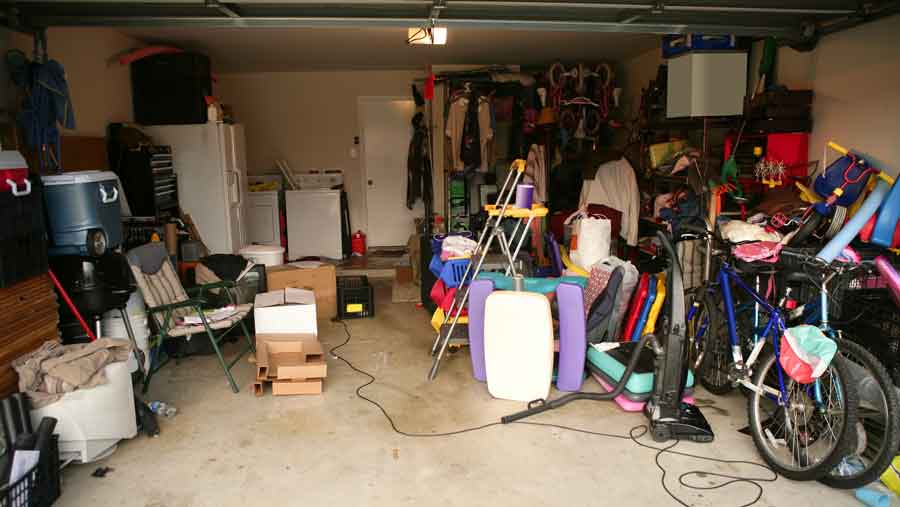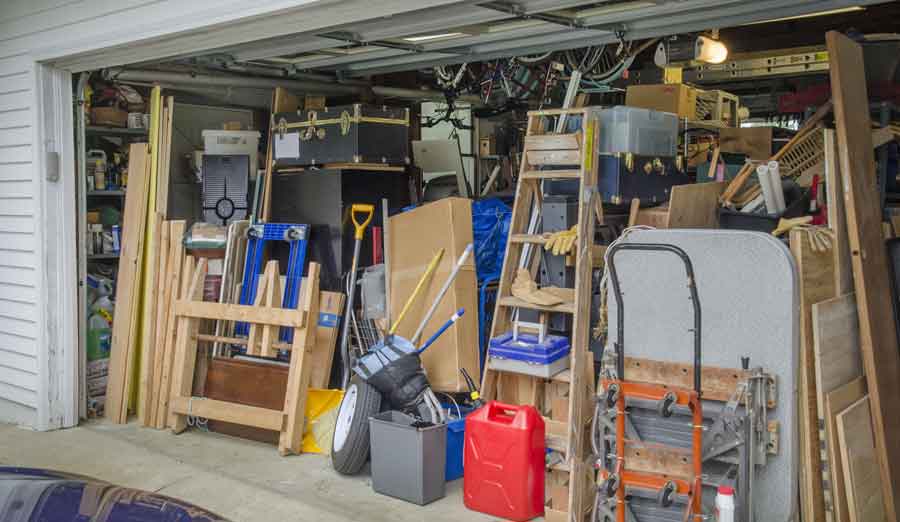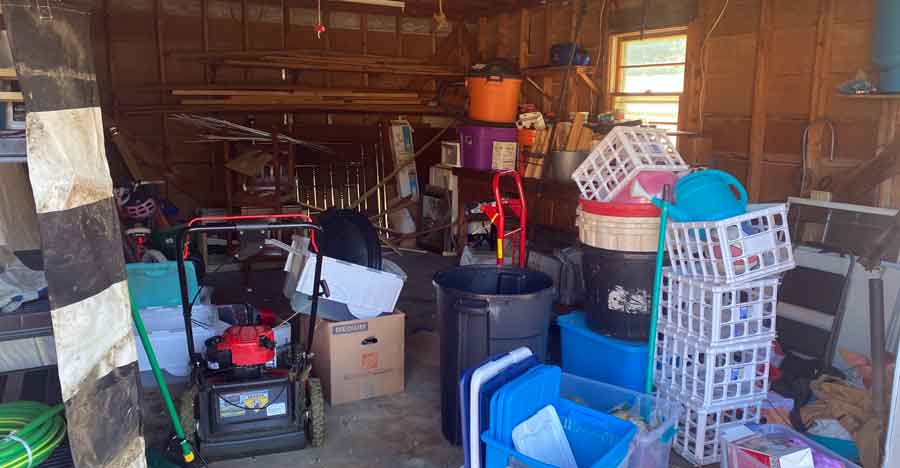Depending on the survey, somewhere between 15%-25% of Americans can’t park their car inside their garage.
In other words, there’s so much stuff in American garages they can’t fit the one thing that’s supposed to be there:
Your car.
So if you’re one of those frustrated that you can’t park inside, then you’ll love this.

You’re not going to spend all weekend “rage cleaning.”
Today, we’re going to learn how to clean out your garage, but we’ll do things a bit differently.
The goal is to set up a process to declutter your garage that you can do over time. Most importantly, it’ll be easy to keep up with, so your garage will never be a disaster again.
However, if you’re feeling overwhelmed, there’s no shame in hiring a garage cleanout service to help out.
How to Clean Out Your Garage: Lessons Learned from Video Games
Most people don’t clean out their garage because they make it one BIG project instead of several smaller ones.
What does decluttering your garage have to do with video games?
No matter what type of game you play (sports games, shooters, or RPGs), video games are designed to give you little bits of satisfaction often.
That’s why they’re so addictive.
We’ll treat cleaning out your garage like a video game and give yourself those little wins often.
The “video game method” is a way to declutter your garage that focuses on two things:
- Breaking one colossal task down into smaller chunks (shorter quests)
- Setting time limits to keep you motivated
I recommend setting a time limit of no more than one hour or one small task. After that, if you’re still feeling good and motivated, keep going. But be OK with stopping too.
We want to make this a lifestyle change so you’ll keep your garage clutter free.
Let’s start with the first level to get you used to the game.
Declutter Your Garage Level 1: Eliminate The Easy Clutter
Games usually have a boss early on that seems challenging at the time, but you’ll look back on it later and think how easy it was.
Let’s get an easy win. We’ll start to declutter your garage by cleaning out some of the big items first. This will make a huge difference and clear out a little space to work with.
If you have any of these items in your garage, throw them out right now.
- Packaging Clutter in Garages: Garages often become cluttered with empty boxes, styrofoam peanuts, and bubble wrap. These items, kept for future shipping needs, can create a mess. Flattening boxes for recycling is easy, but disposing of packing peanuts and bubble wrap can be tricky. They can scatter everywhere if not stored properly. Additionally, these materials attract mice. To tackle this, explore local recycling programs or drop-off points for these materials or see if shipping stores will accept them for reuse or recycling.
- Dealing with Broken Tools: Broken tools clutter garages, hindering the search for needed items and posing safety risks. Don’t toss them in regular trash. Instead, recycle them at local centers or scrap yards. Many cities offer special hazardous waste disposal days for such items. Ensure batteries or fluids are removed and properly disposed of before recycling (see #18).
- Old or Broken Furniture: Garages are often home to outdated or broken furniture like an old floral sofa, which consumes space and can be unsafe. Check for local “large item” trash days or contact waste management for furniture disposal. Usable furniture can be donated after a thorough cleaning. For completely unusable pieces, inquire about acceptance and preparation guidelines at recycling facilities.
- Electronic Waste Management: Old or broken electronics like TVs and computers quickly fill garage space. Improper disposal can harm the environment. Seek e-waste recycling programs at local waste management facilities or contact manufacturers for recycling options. Remember to erase personal data from devices before disposal.
- Unused Sports Equipment: Throw out old sports gear that’s no longer in use. Consider how often it’s used and its future utility. If it’s worn, broken, or has sentimental value, repurpose it or donate it to charities, schools, or sports programs. Selling it online or at secondhand stores is also an option.
- Dealing with Old Toys: Discarding your child’s outgrown or broken toys frees up garage space and eliminates safety hazards. Donate usable toys or recycle them, ensuring batteries and electronics are removed first.
- Unfinished Projects: Garages often house unfinished projects like woodworking or DIY tasks. If they’re causing stress, consider donating or disposing of them responsibly. This decluttering can inspire others or bring back your space.
- Worn-Out Shoes: Don’t let worn-out shoes clutter your garage. Donate them if they’re still wearable or recycle through shoe brand programs. Proper disposal clears space and reduces waste.
- Holiday Decoration Overhaul: Broken or unused holiday decorations need prompt disposal to avoid clutter and accidents. Recycle non-working lights or electrical items and donate gently used decorations at appropriate times.
- Paper Product Pile-Up: Old books, magazines, newspapers, and manuals attract pests and pose fire hazards. Donate them if in good condition, or recycle them. Keep relevant manuals and consider digital versions to reduce clutter.
- Disposing of Old Tires: Old tires, a common sight in garages, can become a hazard if not correctly disposed of. Their rubber degrades over time, especially under extreme conditions. To avoid environmental issues, take them to a tire recycling center or utilize disposal services offered by tire retailers or auto shops. Remember, burning tires is harmful and releases toxic chemicals into the air.
- Old Paint Management: Stored paint in garages doesn’t last forever and can release harmful fumes. Proper disposal is crucial. Check local regulations for paint disposal, as many areas have hazardous waste collection programs or recycling centers for paint cans.
- Outgrown Baby Gear: Garages often store outgrown strollers, car seats, and baby accessories. These items, with their limited lifespan, can be recycled or donated. Many organizations accept these items for needy families. Avoid dumping them in landfills to prevent environmental harm.
- Expired Cleaning Supplies & Chemicals: Aging cleaning supplies and chemicals in garages pose significant safety risks. Their effectiveness diminishes, and they can become dangerous. Check local guidelines for safe disposal and avoid pouring chemicals down drains to protect the environment.
- Automotive Fluid Disposal: Old automotive fluids like oil and brake fluid harm the environment and shouldn’t be discarded carelessly. Use recycling programs from auto parts stores or local hazardous waste disposal services.
- Unused Car Parts: Unneeded car parts clutter garages and can be problematic if they contain hazardous materials. Selling them online, donating them to mechanics, or recycling them are better alternatives to keeping them unused.
- Garden Tool Overflow: Excess or duplicate garden tools take up valuable space in your garage. Donating them to community gardens or recycling at scrap metal centers are eco-friendly disposal options.
- Battery Recycling: Accumulated batteries in garages need proper disposal due to their harmful chemicals. Retail stores and hardware stores often have battery recycling bins. Check for specific disposal methods for different battery types.
- Firewood Storage: Storing firewood in garages invites insects and moisture-related issues. Outdoor, ventilated storage is better. If firewood is in good condition, consider donating it or offering it on community platforms. For unusable wood, contact local waste management for disposal options.
- Excess Building Materials: Unused building materials in garages, such as spare tiles, can hinder access to other items and become outdated. Repurposing or donating to organizations like Habitat for Humanity ReStore is advisable. If donation isn’t an option, check for local recycling or disposal programs.
Declutter Your Garage Level 2: Sorting Your Inventory
Now that you’ve got some open floor space in your garage to work let’s plan the next area to tackle.
You can think of this as your first side-quest on the way to your final goal.
My first step was to organize items into piles of similar products. Put all of your tools in one place. Put all of your garden items in another. Car products in a third, and separate garage storage for toys.
We’re not making any non-obvious decisions on what to keep or throw out in this step. However, if something is hopelessly broken, then toss it.
It’s essential to keep some empty space between the piles, so there’s a distinction between them. Psychologically, you’ll see that as two smaller projects instead of one large project.
I’m not a fan of the “open your garage doors, take everything out, and pile it up in your driveway” method because it makes you feel overwhelmed and miserable.
In my case, I had piles of tools, garden supplies, sports equipment, old paint, spare flooring tiles, Christmas lights and decorations, and lots of miscellaneous tubs around the sides of our garage.
We could still park two cars in there…but only barely.
Depending on how long this takes (remember you set a time limit!), this may be the end of today’s garage decluttering session.
If so, congratulations!
You brought some order to your chaos.
That’s a big win!

Delutter Your Garage Level 3: Putting Items In Their Place
Now comes the first real challenge. Pick one of the piles you made in Level 2, and we’ll make it go away.
I’m not trying to be obvious, but decluttering is all about getting rid of the stuff you don’t need. As Marie Kondo would say, get rid of it if it doesn’t bring you joy.
That’s right. I still found a way to work Marie Kondo into a “declutter your garage” article with a video game theme.
Boom.
At any rate, you’ll probably see where this is going…
Separate all the clutter into three piles:
- Stuff to throw out
- Stuff to donate or sell
- Stuff to keep
Start with the first pile, go through each item, and decide if it still has a place in your life.
Don’t jump between piles. Finish one before starting the next.
If it does, great. If it doesn’t, throw it out or put it off to the side to donate or sell.
I know… It’s not rocket science, but it works.
Danger ahead: “What if I need this someday?”
Let me be serious for a minute:
If you save stuff because you think you’ll need it someday…
You probably won’t.
Keeping junk that you don’t need because of “someday” is how your garage became a cluster**** in the first place.
If something doesn’t have a place in your life consistently, it needs to go. Remember, the goal in this level is to purge unnecessary junk!
Let me give you a couple of examples of what to look for:
- If you’ve moved anytime in the past ten years, you’ve probably got storage boxes of clutter from your old home that you haven’t unpacked yet (guilty).
- You bought something on sale because it was cheap, but you never really found a use for it once you got it home.
- Items that seem cute, but are just wasting space because you’re not using them anymore.
- Something that used to hold a sentimental value but…not so much anymore.
- Broken items that you swear you’ll get around to fixing…someday.
If you haven’t used something in the 6-12 months, then you don’t need it in your life.
This excludes seasonal things like holiday decorations, seasonal toys or sporting goods, or anything else stored in your garage but gets regular use at specific times of the year.
When in doubt, get rid of it.
Remember, the more items you keep, the more things you’ll have to find a home for later.
Trash, Sell, or Donate?
You only have a set number of inventory slots in most games. That means you’re constantly choosing what stuff to drop on your travels (Trash) or sell to a local trader (Donate or Sell) to make room for the things you want to keep.
When I have an item in my home that I know I want to get rid of, but I don’t know whether to sell it, donate it or trash it, I just check eBay.
Seriously.
Go to eBay, search for the item and find recently completed listings. If you see a few that have sold for a price you think is fair (and worth your time), then either sell the item or donate it.
Be sure to check several listings to get an idea of shipping charges. I’ve sold things on eBay that have cost more to ship than I made from selling it. I’ve also had my profits disappear once I got hit with Seller’s Fees at the end of the month.
Two tough lessons learned.
If the item is small and valuable, I’ll usually list it on eBay.
Personally, I avoid selling it locally through Craigslist, Facebook Marketplace, or a garage sale because I don’t want the hassle. It may be for you, but it’s just not my thing.
If the item is big and bulky (i.e., it will cost a lot to ship through UPS), I’ll donate it. This also helps for tax purposes at the end of the year.
To be honest, most of my garage items are donated or end up in a trash can. Very little is worth my time selling.
Before moving on
It’s easy to start feeling like you’ve spent forever just moving a mess around and maybe throwing out some clutter here and there.
Once you’ve completed a couple of piles (that means thrown out or taken to Goodwill to donate), you could take a stab at Level 4 and then come back to finish off this level later.
In my case, I tried to clean out one complete side of my garage first. That included all my garden tools and tool cases, but not any spare tiles or other house items.
I cleaned and organized it before jumping back to work on the other side.
The danger of this is that you could see the progress of half of your garage cleaned out and fall back into the trap of hoarding clutter and junk everywhere.
But, if done right, it could give you even more motivation to finish decluttering your garage quickly.
It’s up to you how you want to play this level. Think of it like an “open world garage cleaning.”

Declutter Your Garage Level 4: Storage Solutions
Whether you’re completely finished with your Level 3 purge or dipping your toes into this level to see some quick results and keep your motivation up, it doesn’t matter.
It’s time to set up a logical storage system and get organized.
You could fill a book about how to organize your garage. Trust me, many people have done just that.
You must change the way you look at (and live with) your garage if you want to make a lasting change.
At this level, we’ll plan ahead to ensure that the biggest challenge areas will stay clean and organized.
Here are a couple of tips to get you started.
Tip #1: Keep everything off the floor
The easiest way to clutter up your garage is to start making piles on the floor. It won’t be long before you have to declutter your garage again.
Part of keeping your garage clutter free is to keep everything off the floor.
I took this to an extreme in my garage. I mounted my garage cabinets on the walls to sweep or hose the floor underneath them.
Tip #2: Look up
What should you do with all those piles on the floor? Just look up.
Most modern garages are at least ten feet high. That leaves plenty of room for a wire-frame shelf system mounted to the ceiling, a DIY rack for plastic tubs, or even just a shelf above the garage door.
Tip #3: One of everything and everything in its place
You could also call this tip “how not to be a hoarder.”
My goal is to have one of everything. No more. No less.
I want a screwdriver set. One hammer. One tape measure. One socket set. Etc.
Why? Because I can only use one at a time. Obviously, if two people in the house use tools regularly, have some select duplicates.
The exception is if you work at job sites and have a travel set of tools and a home set. In that case, go ahead and have two sets of tools, but keep them organized.
In my case, I had three tape measures, two socket sets, three stud finders, and four sets of small screwdrivers. I could happily eliminate the duplicates to streamline my toolbox and free up wasted space.
How to Declutter Your Garage: Final thoughts
Remember, the goal is to declutter your garage as quickly and painlessly as possible.
- Break it down into small chunks and work on only those areas.
- Take breaks often to keep yourself motivated
- Simplify where you can
- Look for smart storage solutions to keep your garage clutter free and easy to maintain in the future.
